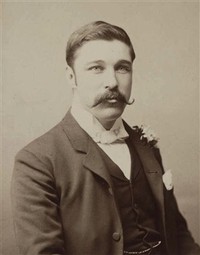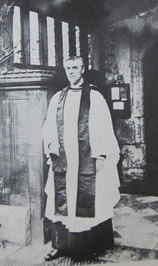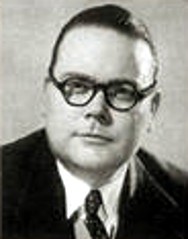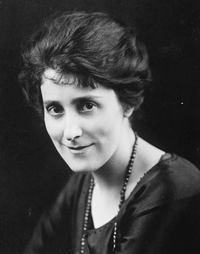
Anthony Weymouth
"Anthony Weymouth" was a pseudonym of Ivo Geikie Cobb, a Harley Street doctor who (amongst other things) wrote detective stories with medical themes.
If you like author Anthony Weymouth here is the list of authors you may also like
Buy books on AmazonAnthony Weymouth similar authors
-

Fergus W. Hume
Fergusson Wright Hume (1859–1932), New Zealand lawyer and prolific author particularly renowned for his debut novel, the international best-seller The Mystery of a Hansom Cab (1886).
Buy books on Amazon
Hume was born at Powick, Worcestershire, England, son of Glaswegian Dr. James Collin Hume, a steward at the Worcestershire Pauper Lunatic Asylum and his wife Mary Ferguson.
While Fergus was a very young child, in 1863 the Humes emigrated to New Zealand where James founded the first private mental hospital and Dunedin College. Young Fergus attended the Otago Boys' High School then went on to study law at Otago University. He followed up with articling in the attorney-general's office, called to the New Zealand bar in 1885.
In 1885 Hume moved to Melbourne. While h -

Frances Noyes Hart
Frances Newbold Noyes Hart (August 1890 – October 25, 1943) was an American writer whose short stories were published in Scribner's magazine, the Saturday Evening Post, the Ladies' Home Journal.
Buy books on Amazon -

Fergus Hume
Fergusson Wright Hume (1859–1932), New Zealand lawyer and prolific author particularly renowned for his debut novel, the international best-seller The Mystery of a Hansom Cab (1886).
Buy books on Amazon
Hume was born at Powick, Worcestershire, England, son of Glaswegian Dr. James Collin Hume, a steward at the Worcestershire Pauper Lunatic Asylum and his wife Mary Ferguson.
While Fergus was a very young child, in 1863 the Humes emigrated to New Zealand where James founded the first private mental hospital and Dunedin College. Young Fergus attended the Otago Boys' High School then went on to study law at Otago University. He followed up with articling in the attorney-general's office, called to the New Zealand bar in 1885.
In 1885 Hume moved to Melbourne. While h -

Victor L. Whitechurch
Victor Lorenzo Whitechurch was born in 1868, was educated at Chichester Grammar School and Chichester Theological College and eventually became a canon of the Anglican Church, living and working for many years in the country rather than in towns and cities.
Buy books on Amazon
He held various positions as curate before he became vicar of St. Michael's, Blewbury in 1904. In 1913 he became Chaplain to the Bishop of Oxford, and an honorary canon of Christ Church and in 1918 he became Rural Dean of Aylesbury.
He began his writing career with religious works, as befitted his profession, and edited 'The Chronicle of St George' in 1891 before producing his own work 'The Course of Justice' in 1903. He wrote his first quasi-detective novel, also considered as a clerical -

E.C.R. Lorac
Edith Caroline Rivett (who wrote under the pseudonyms E.C.R. Lorac, Carol Carnac, Carol Rivett, and Mary le Bourne) was a British crime writer. She was born in Hendon, Middlesex (now London). She attended the South Hampstead High School, and the Central School of Arts and Crafts in London.
Buy books on Amazon
She was a member of the Detection Club. She was a very prolific writer, having written forty-eight mysteries under her first pen name, and twenty-three under her second. She was an important author of the Golden Age of Detective Fiction. -

Carol Carnac
Edith Caroline Rivett (who wrote under the pseudonyms E.C.R. Lorac, Carol Carnac, Carol Rivett, and Mary le Bourne) was a British crime writer. She was born in Hendon, Middlesex (now London). She attended the South Hampstead High School, and the Central School of Arts and Crafts in London.
Buy books on Amazon
She was a member of the Detection Club. She was a very prolific writer, having written forty-eight mysteries under her first pen name, and twenty-three under her second. She was an important author of the Golden Age of Detective Fiction. -

Victor L. Whitechurch
Victor Lorenzo Whitechurch was born in 1868, was educated at Chichester Grammar School and Chichester Theological College and eventually became a canon of the Anglican Church, living and working for many years in the country rather than in towns and cities.
Buy books on Amazon
He held various positions as curate before he became vicar of St. Michael's, Blewbury in 1904. In 1913 he became Chaplain to the Bishop of Oxford, and an honorary canon of Christ Church and in 1918 he became Rural Dean of Aylesbury.
He began his writing career with religious works, as befitted his profession, and edited 'The Chronicle of St George' in 1891 before producing his own work 'The Course of Justice' in 1903. He wrote his first quasi-detective novel, also considered as a clerical -

Miles Burton
AKA John Rhode, Cecil Waye, Cecil J.C. Street, I.O., F.O.O..
Buy books on Amazon
Cecil John Charles Street, MC, OBE, (1884 - January 1965), known as CJC Street and John Street, began his military career as an artillery officer in the British army. During the course of World War I, he became a propagandist for MI7, in which role he held the rank of Major. After the armistice, he alternated between Dublin and London during the Irish War of Independence as Information Officer for Dublin Castle, working closely with Lionel Curtis. He later earned his living as a prolific writer of detective novels.
He produced two long series of novels; one under the name of John Rhode featuring the forensic scientist Dr Priestley, and another under the name of Miles Burton featurin -

R.A.J. Walling
Robert Alfred John Walling (11 January 1869, Exeter – 4 September 1949 Plympton) was an English journalist and author of detective novels, who signed his works "R. A. J. Walling".
Buy books on Amazon
See also Robert Alfred John Walling. -

Clifford Witting
Clifford Witting (1907-68) was an English writer who was educated at Eltham College, London, between 1916 and 1924.
Buy books on Amazon
During World War II he served as a bombardier in the Royal Artillery, 1942-44, and as a Warrant Officer in the Royal Army Ordnance Corps, 1944-46.
He married Ellen Marjorie Steward in 1934 and they had one daughter. Before becoming a full-time writer, he worked as a clerk in Lloyds bank from 1924 to 1942. He was Honorary Editor of The Old Elthamian magazine, London. from 1947 up to his death.
His first novel 'Murder in Blue' was published in 1937 and his series characters were Sergeant (later Inspector) Peter Bradford and Inspector Harry Charlton. Unusually, he didn’t join The Detection Club until 1958 by which time he had writt -

Henrietta Clandon
"Vernon Loder was a pseudonym for John George Hazlette Vahey (1881-1938), an Anglo-Irish writer who also wrote as Henrietta Clandon, John Haslette, Anthony Lang, John Mowbray, Walter Proudfoot and George Varney. He was born in Belfast and educated at Ulster, Foyle College, and Hanover. Four years after he graduated college he was apprenticed to an architect and later tried his hand at accounting before turning to fiction writing full time." - DSP
Buy books on Amazon -

Christopher Bush
Christopher Bush was educated in the local school. He then won a scholarship to Thetford Grammar, and went on to study modern languages at King's College London, after which he worked as a school teacher.
Buy books on Amazon
He participated in both world wars.
He was a prolific writer of detective novels, wrote three autobiographical novels and nine books about Breckland life using the nom-de-plume Michael Home.
He lived in Great Hockham. -

Mary Fitt
"Mary Fitt" was the pen-name used for her crime novels by Dr. Kathleen Freeman, who for several years was Lecturer in Greek at the University of Wales at Cardiff.
Buy books on Amazon -

Francis Beeding
Francis Beeding is the pseudonym used by two British male writers, John Leslie Palmer (1885-1944) and Hilary St George Saunders (1898-1951). The pseudonym was a joint effort and was apparently chosen because Palmer always wanted to be called Francis and Saunders had once owned a house in the Sussex village of Beeding.
Buy books on Amazon
The pair met when undergraduates at Oxford and remained friends when they both worked at the League of Nations in Geneva and it was while there that they decided to collaborate on writing detective novels.
Discussing their collaboration at one time Saunders commented, 'Palmer can't be troubled with description and narrative, and I'm no good at creating characters or dialogue.' Whatever the reason it certainly worked.
Palmer was d -

Eimar O'Duffy
It can sometimes seem that Eimar O’Duffy (1893-1935) is most remembered for being a forgotten writer. John Hogan begins his slim 1972 biography of O’Duffy with the line “Eimar Ultan O’Duffy is virtually a forgotten writer”, then quotes Vivian Mercier’s 1946 essay on O’Duffy: “The late Eimar O’Duffy . . . was simply ignored.”
Buy books on Amazon
O'Duffy, of Anglo-Irish stock, became a captain in the Irish Volunteers and was sent by Eoin MacNeill, along with Bulmer Hobson, to stop the 1916 insurrection in Belfast. He wrote a wide variety of books and plays, but it is the Cuanduine trilogy that is his great achievement. King Goshawk and the Birds is the first part of the trilogy and is an important landmark in the Irish comic novel tradition.
(From the Irish Times) -

Clemence Dane
Clemence Dane was the pseudonym of Winifred Ashton.
Buy books on Amazon
Clemence Dane (name for the London church, St Clement Danes) was the pseudonym of Winifred Ashton, an English novelist and playwright (1888-1965). Between World Wars I and II, she was arguably Britain’s most successful all-round writer, with a unique place in literary, stage and cinematic history. Dane won an Oscar for her screenplay “Vacation from Marriage,”. School teacher, novelist, playwright and magazine editor, Dane wrote at least 30 plays and 16 novels.
One series she was famous for was The Babyons, by Clemence Dane. Four long stories strung together by a supernatural thread and chronicling the family history of the Babyons over a period of about 200 years. The ghostly thread is intro